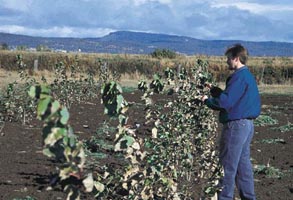pH I Love You

When pear trees become stunted, alfalfa roots rot and hydrangea blossoms turn blue, Oregon farmers suspect a familiar culprit: acidic soil.
Drop by drop, year by year, Oregon's abundant rains leach away basic ions of calcium, magnesium, sodium and potassium from the soil.
"It is a slow, insidious type of acidification," said Richard Smiley, a professor of plant pathology with Oregon State University's Agricultural Experiment Station and superintendent of the Columbia Basin Agricultural Research Center in Pendleton.
Scientists like Smiley compare the effects of soil acidification to driving a car without a gas gauge: You may be able to drive for hundreds of miles with no problems, but if you don't gas up, the car stops dead.
 |
|
The soil's pH level, or degree of acidity or alkalinity, is a concern statewide for farmers. Here, USDA soil scientist Paul Rasmussen, left, and OSU plant pathologist Dick Smiley take a sample from a long-term wheat research plot at the Columbia Basin Agricultural Research Center near Pendleton. The plots are used to study the impact of various farming practices. Photo: Lynn Ketchum |
Western Oregon farmers usually don't wait for a crop failure before they act. It is common knowledge among them that lime application is essential to healthy crops because plants draw 14 of their 17 essential nutrients from the soil. They cannot do this if the soil is too acidic.
Lime counteracts soil acidity because it is very alkaline (see sidebar, "Of Saliva and Seawater"). Applying lime to the top layers of soil increases its pH, reduces acidity and enables absorption of nutrients.
The need to monitor soil pH has never been greater, Smiley said, because agricultural fields all over Oregon are turning up acidic where they never had been before. "Even out in the drier sections of the Columbia Plateau, the need for liming is going to occur sometime in our lifetime. Our growers are not accustomed to applying lime to this region," he said.
Why are acidic soils becoming more common? Increased irrigation in previously dry areas, certain crop rotation practices and the widespread use of nitrogen fertilizers all contribute to the problem.
Since 1931, researchers at the Columbia Basin Agricultural Research Center have documented the relationship between applying nitrogen fertilizer and how quickly and to what extent soils become acidified.
 |
|
Franz Niederholzer, until recently an OSU Extension Service specialist at Hood River, with equipment he uses to take soil samples. Soil pH affects fruit production in the area's pear and apple orchards. A low pH can reduce growth and promote manganese toxicity. Photo: Lynn Ketchum |
"In the foothills, where both nitrogen and rainfall are higher, soil pH is down to a level where it might be limiting for crop production," Smiley said. "For example, you might find measurements of acidity down to 4.5 pH compared to the 5.5 or 6.0 pH that you might find in soil that had never received nitrogen fertilizer."
In 1996, he and other scientists published a report that showed a relationship between soil acidity and root diseases in some cereal crops.
Soil acidity affects many other crops as well.
 |
|
Gene Pirelli, an OSU extension agent in Polk County, inspects a pasture where lime was applied to keep the grass green. Photo: Lynn Ketchum |
"It's very important to maintain soil pH," said Franz Niederholzer, an OSU extension agent working with Hood River-area fruit growers until recently, when he left the job to return to his family's farm. "If an orchard has a low soil pH, you see reduced growth and increased manganese toxicity. The environment in which the roots grow becomes chemically harsh. It also effects the health of micro-organisms in the soil."
"Soils can get very acidic before the effect shows on seed yield," said Mark Mellbye, an OSU field crops extension specialist for Linn, Benton and Lane counties. "At a certain critical zone of low pH, yields drop off dramatically and the grass doesn't grow anymore."
In grass seed crops, the damage from acid soils is often below ground as well, Mellbye said. "At a certain pH-4.7 or below-aluminum concentrations increase exponentially and are toxic to roots. It can be so bad that seedlings germinate and the roots are so puny and ineffective that the plant just dies."
Keeping pasture grasses thriving also requires lime, said Gene Pirelli, a livestock specialist for 19 years, now at OSU's Polk County Extension office.
"A livestock producer is a producer of grass and clover, and you are using your animals to harvest that crop," Pirelli said. "If you produce less grass, there is less available forage so you can't raise as much milk and meat on an acre."
 |
|
Western Oregon's rain can leach away minerals, creating acidic soil not good for certain crops. Farmers counteract this with a white, powdery coating of lime, which is alkaline. Photo: Lynn Ketchum |
To counter this, Pirelli recommends putting lime in a top-dressing on fields in the fall and letting heavy November rains wash it off the leaves and into the soil. "Once it's washed off, you can graze," he said. But results aren't immediate. The lime becomes incorporated into the soil at a rate of about an inch a year.
A field's crop history also can speed up soil acidification, said Mylen Bohle, an extension agent in Crook County. "If you've got cereals, grasses or mint, you're going to drop the (soil) pH over time. And it has caught up with us now," he said. "In Central Oregon, we're starting to use more (lime) because of these acid-based nitrogen fertilizers that lower the pH. As it goes lower, the rhizobia nitrogen-fixing bacteria) can't make their own nitrogen."
This condition is common in Western Oregon, but Crook Country farmers are accustomed to alkaline, not acidic, soils.
"It was of less concern 20 years ago," Bohle said of acid soils. "Each year that passes by, there is going to be more and more concern over (low) pH. What we've done with irrigation and fertilization is to completely change the microclimate."
Nowhere is that more evident than in Union County, where Gordon Cook is an agriculture extension agent. "Here in Union County in the Grand Ronde Valley, we have a 15-mile difference between extremes of pH," he said.
In the northern portions of the valley, farmers have started applying lime in the top foot of the soil to reduce its acidity. At the southern end of the valley, drainage is very poor and the soils are alkaline. Farmers plow in gypsum and as much organic matter as possible to aerate and to correct soil pH.
"The alkalinity has been here over a long time," Cook said. "Acidity has come with nitrogen and increased irrigation."
Although the solution-adding lime-seems simple, farmers and soil specialists say there are complicating factors. Chief among them is cost.
Quality lime from crushed limestone can cost $85 an acre to apply. Lower-cost alternatives, including lime from sugar beet processing or paper making, can cost upwards of $50 an acre.
Marvin Kauffman earned his doctorate in soil science from OSU in 1976 with a thesis on lime mixing and application. He now works closely with farmers through his own soil consulting firm in Albany. He is familiar with the real-world reason why good farmers delay lime application, despite knowing its benefits.
 |
 |
|
|
Extension agent Scott Leavengood examines hybrid poplar trees growing at OSU's Klamath Experiment Station in soils with different pH levels. |
||
"One dilemma is where landowners are renting by the year to the highest bidder," he said. "Liming is a long-term investment. If you put an adequate amount on, it is there for a good number of years."
But if a renter is in danger of losing his field to a higher bidder the following year, he may not be as eager to spend the money for liming.
"You can't blame them," Kauffman said.
Another reason farmers may not apply lime is uncertainty about where and how much to apply. Some farmers, such as Dennis Glaser of Mid-Valley Farms between Lebanon and Tangent, are experimenting with Global Positioning Satellite (GPS) technology. It is valuable both to measure crop yields and to precisely determine how much fertilizer and soil amendments a field requires.
Two summers ago, Glaser had a GPS system installed on his combines. This year, he had access to new soil maps for Linn County that were digitized and placed on computer discs by the U.S. Department of Agriculture.
"They just came available this past summer," Glaser said. "Lime seemed like a logical entry point into variable-rate application." Working land where his father started farming grass seed in 1946, Glaser said he's trying to increase the soil's pH in hopes of rotating grass seed fields into clovers, meadowfoam or wheat.
"Last year, we used byproduct lime from the James River plant in Halsey," Glaser said. "We must have spread four tons over 2,000 acres in 1998. This year, we started to use grid sampling on everything we limed this fall-about 1,500 acres."
The lime was applied according to a variable rate in 2- and 5-acre grids. "We're going to analyze (the results) this winter," Glaser said.
Already, some of the amounts of lime application required through this automatic variable-rate process surprised Glaser. Some fields that were limed in 1998 were shown to require an additional 3 tons of lime per acre to bring them to a target pH of 6, he said.
Glaser sees GPS technology as a good solution, but farmer Greg Bingaman in La Grande said its applications are limited.
 |
|
A truck applies lime to a grass seed field in the central Willamette Valley. The goal is to reduce soil acidity. Photo: Lynn Ketchum |
Bingaman recently adopted a GPS system to monitor his crop yield data. But he doubts he will be using it for lime application any time soon. Once again, the limiting factor is cost.
"It's fairly expensive," Bingaman said. While traditional fertilizing methods cost about $3.50 an acre, the cost per acre of variable rate fertilizing jumps to about $15 an acre, he said.
But in a situation of "pay me now, or pay me later," farmers are going to have to decide whether they go high-tech with their liming practices, continue preventive liming and hope they don't overdo it-or simply hope for the best.
One thing they can't do is ignore the problem. "The biggest single factor on yields in the [Willamette] Valley is water," said Glaser. "The second is lime."
